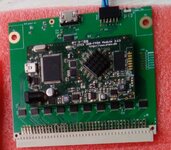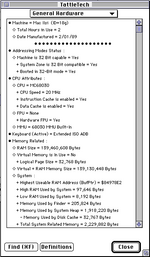Hello all,
Following the NuBusFPGA (thread here), here comes the IIsiFPGA, adding the Highly Desirable Macintosh Interface to the Macintosh IIsi.
The IIsiFPGA is the same concept than the NuBusFPGA, uses the same FPGA daughterboard, but is designed to be connected to the 120-pins DIN 41612 connector used by some 68030-based Macintosh, with the Macintosh IIsi the one it was designed for and tested in.
I'm not sure if it will fit mechanically in the SE/30, but should be electrically compatible.
It might also be adapted to work in a IIfx, but with some limitations (the IIfx clock signal uses a different pin than the IIsi or SE/30, and some other weirdness)
I do not own a SE/30 or a IIfx so I'm not going to be able to test either anytime soon.
Currently the full Framebuffer available in the NuBusFPGA is supported, including audio & acceleration. It's much slower than a NuBusFPGA in a Q650, so I suspect the CPU performance is quite important for QuickDraw.
The current goal is to use the unused DDR3 memory as additional memory for the system, but so far the ROM has been resistant to my attempts (I'm using a Flash ROM SIMM and associated programmer, thanks to the designers for creating and sharing such a great way of 'improving' the ROM). For now, I can 'see' my memory from a usercode by enabling it through the TT0 (Transparent Translation) register of the MMU, and the CPU will appropriately use burst if the CI (cache inhibit) bit is not set (burst doesn't work yet but it's a way to debug it). However, I can't just expand the Memory Chunk table, as some parts of the ROM assume a MDU-based system like the IIsi only has two banks, which might be split in three 'pseudo-banks' to accomodate the internal video. I need another bank to be mapped by the MMU, along with appropriately updated globals (such as the total memory size).
The board can be plugged 'vertically' in the PDS slot, but you can't close the case; it is also known to work (and improve the situation!) with my own IIsi PDS adapter, at least the PLCC version. Turns out there's enough clearance to fit the IIsiFPGA parallel to the motherboard with no issue - other than potentially the system overheating.
Like the NuBusFPGA, it's all on GitHub, see the link(s) in the first line of this post.
Edit: let's have a picture

Following the NuBusFPGA (thread here), here comes the IIsiFPGA, adding the Highly Desirable Macintosh Interface to the Macintosh IIsi.
The IIsiFPGA is the same concept than the NuBusFPGA, uses the same FPGA daughterboard, but is designed to be connected to the 120-pins DIN 41612 connector used by some 68030-based Macintosh, with the Macintosh IIsi the one it was designed for and tested in.
I'm not sure if it will fit mechanically in the SE/30, but should be electrically compatible.
It might also be adapted to work in a IIfx, but with some limitations (the IIfx clock signal uses a different pin than the IIsi or SE/30, and some other weirdness)
I do not own a SE/30 or a IIfx so I'm not going to be able to test either anytime soon.
Currently the full Framebuffer available in the NuBusFPGA is supported, including audio & acceleration. It's much slower than a NuBusFPGA in a Q650, so I suspect the CPU performance is quite important for QuickDraw.
The current goal is to use the unused DDR3 memory as additional memory for the system, but so far the ROM has been resistant to my attempts (I'm using a Flash ROM SIMM and associated programmer, thanks to the designers for creating and sharing such a great way of 'improving' the ROM). For now, I can 'see' my memory from a usercode by enabling it through the TT0 (Transparent Translation) register of the MMU, and the CPU will appropriately use burst if the CI (cache inhibit) bit is not set (burst doesn't work yet but it's a way to debug it). However, I can't just expand the Memory Chunk table, as some parts of the ROM assume a MDU-based system like the IIsi only has two banks, which might be split in three 'pseudo-banks' to accomodate the internal video. I need another bank to be mapped by the MMU, along with appropriately updated globals (such as the total memory size).
The board can be plugged 'vertically' in the PDS slot, but you can't close the case; it is also known to work (and improve the situation!) with my own IIsi PDS adapter, at least the PLCC version. Turns out there's enough clearance to fit the IIsiFPGA parallel to the motherboard with no issue - other than potentially the system overheating.
Like the NuBusFPGA, it's all on GitHub, see the link(s) in the first line of this post.
Edit: let's have a picture

Last edited:

